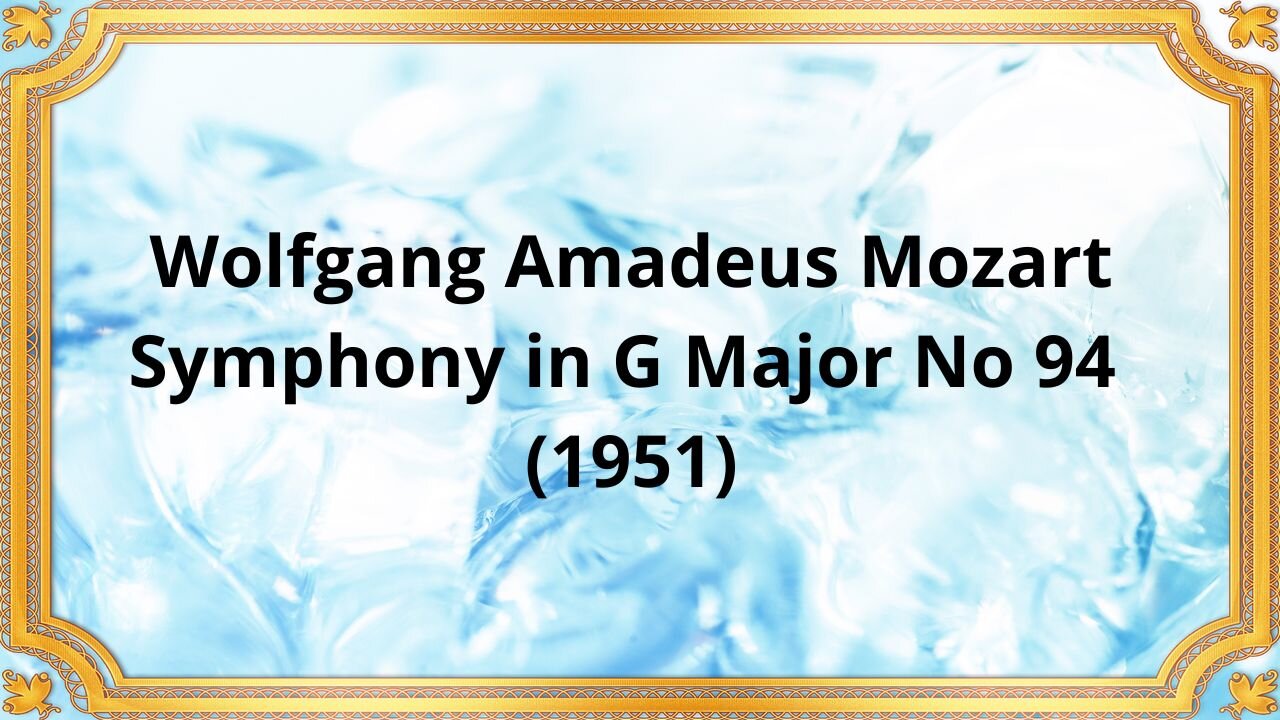Premium Only Content

Wolfgang Amadeus Mozart Symphony in G Major, No 94 (1951)
#mozartlullabies #ClassicalMusic #SymphonyInGMajor #MusicComposition #MozartSymphonyNo94 #MusicHistory #ClassicalComposers #18thCenturyMusic #OrchestralMusic #ClassicalSymphonies #MozartAnalysis #MusicAppreciation #GMajorSymphony #MozartLegacy #MozartInfluence #MusicGenius
Publication date 1951
2 Oboes : 2 Horns : 2 Bassoons
KARL MAYERHOFER Oboe
BRUNO DOERRSCHMIDT Oboe
GOTTFRIED von FREIBERG Horn
LEOPOLD KAIN Horn
KARL OEHLBERGER Bassoon
RUDOLPH HANSLL Bassoon
Wolfgang Amadeus Mozart's Symphony in G Major, No. 94, also known as the "Surprise Symphony," is a remarkable composition that showcases Mozart's mastery of classical music. Composed during the classical period, this symphony is beloved for its melodic beauty, expressive dynamics, and unexpected surprises.
Composed in 1791, Mozart's Symphony in G Major, No. 94, was written during a time of great productivity and creativity for the composer. This symphony was one of twelve that he composed during his time in London, where he enjoyed immense popularity. Symphony No. 94 earned its nickname "Surprise Symphony" due to its unexpected contrasting dynamics, which delighted audiences and added an element of surprise to the performance.
Symphony No. 94 follows the traditional four-movement structure typical of classical symphonies. The first movement, marked Adagio - Vivace assai, opens with a slow and expressive introduction before transitioning into a lively and energetic main theme. This movement showcases Mozart's ability to create beautiful melodies and develop them with rich orchestration and brilliant harmonies.
The second movement, marked Andante, is where the symphony earns its nickname. After a gentle and peaceful opening, Mozart introduces a sudden and fortissimo chord. This unexpected surprise captivates the audience and adds a playful element to the symphony. The movement then continues with graceful melodies and delicate textures, displaying Mozart's gift for creating emotional depth and contrast.
The third movement, marked Menuetto: Allegro molto, is a spirited and lively dance-like movement. It features a memorable main theme that is expertly developed throughout the movement. Mozart's use of rhythmic playfulness and elegant harmonies further enhances the charm and character of this movement.
The final movement, marked Allegro molto, is a vibrant and joyful conclusion to the symphony. It is characterized by its fast tempo, lively rhythms, and exuberant melodies. Mozart's expert handling of orchestration and his ability to balance lightness with moments of grandeur make this movement an exhilarating finale.
Mozart's Symphony No. 94 is renowned for its melodic richness, precise craftsmanship, and unexpected surprises. The famous surprise in the second movement was a deliberate compositional choice by Mozart to engage and entertain the audience. This unexpected dynamic contrast adds a sense of drama and anticipation, ensuring that the symphony remains memorable and distinctive.
Furthermore, Mozart's Symphony No. 94 is a testament to his compositional genius, with its delightful melodies, refined harmonies, and meticulous attention to detail. The symphony showcases Mozart's ability to seamlessly blend classical elegance with emotional depth, creating a truly enchanting musical experience.
Wolfgang Amadeus Mozart Symphony in G Major, No. 94, the "Surprise Symphony," is a masterpiece that continues to captivate audiences with its melodic beauty, surprising elements, and technical brilliance. Mozart's ability to create memorable themes, evoke a range of emotions, and maintain a sense of playfulness throughout the symphony demonstrates his unparalleled talent as a composer. Symphony No. 94 stands as a shining example of Mozart's enduring legacy and his significant contributions to the world of classical music.
You have the opportunity to support the channel:
https://destream.net/live/RadSiarAl/donate
https://www.buymeacoffee.com/6355radsiaral
-
 23:19
23:19
Classical music_Music Inspiration
3 days agoLudwig van Beethoven Sonata No. 23 in F minor, Op. 57 "Appassionata"
201 -
 LIVE
LIVE
MYLUNCHBREAK CHANNEL PAGE
23 hours agoFault Lines are GATES - Pt 3
438 watching -
 LIVE
LIVE
Sgt Wilky Plays
1 hour agoRumble Gaming Bad Company Presents WARZONEPALOOZA
125 watching -
 LIVE
LIVE
Rallied
54 minutes ago $0.40 earnedSolo Challenges ALL DAY
102 watching -
 17:54
17:54
Nate The Lawyer
4 hours ago $1.38 earnedChicago Mayor’s $600M Migrant Spending Leaves City $1.1B Budget CRISIS.
5.8K22 -
 LIVE
LIVE
GritsGG
5 hours agoRumble Customs! 3515 Ws! 🫡!
204 watching -
 LIVE
LIVE
cosmicvandenim
14 hours agoVAN DENIM x RALLIED & GRITS | Team 6: Denim Grit | Warzonepalooza Tournament
222 watching -
 LIVE
LIVE
GamerGril
1 hour ago💕 The Evil Within 2 💕 | First Time Playthrough | Backseat Gaming Encouraged
60 watching -
 1:03:57
1:03:57
Jeff Ahern
2 hours ago $1.85 earnedThe Saturday show with Jeff Ahern
10.5K3 -
 LIVE
LIVE
ZWOGs
1 hour ago🔴LIVE IN 1440p! - Sgt Wilky's WARZONEPALOOZA - Warzone Resurgence Tournament - Come Hang Out!
44 watching